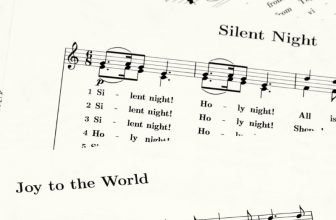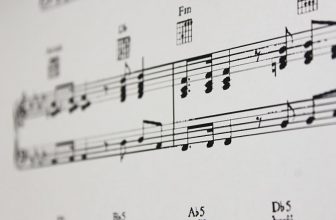The Beginner’s Guide to Music Scales
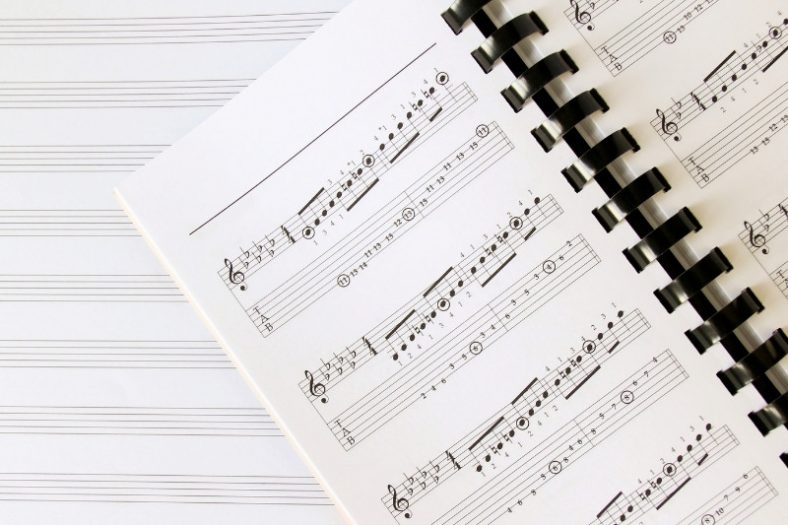
Scales are essential elements in music. Proper knowledge and understanding of scales are a must for musicians, and while they may seem daunting at first, they are learnable.
Contents
What is a scale in music?
A scale is a pattern of whole and half steps (tones and semitones) in the range of an octave. It also encompasses any octave-dividing series of notes, tones, or intervals in music.
Each note in a musical composition usually follows a pattern between selected pitches to create harmony. This refers to the fixed distances (intervals) between one pitch and another in the range of an octave.
A scale’s key element is the interval connections between its pitches, every scale has a specific pattern of intervals. Different sequences of pitches with varying intervals or ranges do not affect the scale’s identity. They may, however, be crucial in defining its role.
How many scales are there in music?
There are forty-eight musical scales in musical compositions, comprising major and minor forms. There are a total of twelve Major scales. But, there are three types of twelve minor scales: natural, harmonic, and melodic.
However, if we count all common scale types or Non-Western types, it might be more than two hundred or even more.
If you think about it, the number of different scales that can be made is almost infinite. But, certain scales become the norm in a certain culture or musical tradition. As a result, the scale of a single piece of music may be representative of a culture’s tone system. In general, the simplest scales may be found in ancient music. In contrast, the most complicated scales are found in the world’s most developed traditions.
What scales are most commonly used?
Major and minor scales are most commonly used in Western music and in time around the world. Chromatic scale follows them in third place.
Before anything, let’s take a look at musical distance and the chromatic scale. This way, you’ll better understand the terms tone, semitone, pitch, interval, and octave.
Ex. Musical Distance on Musical Alphabet
C D E F G A B C
As you can see, there are varying spacings between each note. The pattern illustrates the concept of musical distance. This is crucial in music because there are more notes than what you see in the example mentioned above.
The notes you can’t see in the spacings make a chromatic scale. This includes a half-step or semitone interval between each when they all appear.
Chromatic Scale
Each interval is a semitone in the chromatic scale, the exact distance between neighbor keys on a piano or keyboard. Two semitones together make a whole-step, one tone.
Ex. The distance of one half-step/semitone
C C# D D# E F F# G G# A A# B C
or C D♭ D E♭ E F G♭ G A♭ A B♭ C
There are two ways to spell this alphabet: using sharps (#) or using flats (♭). To clarify, a C# and a D♭ are the same note.
Keep in mind that this alphabet will effectively repeat in both ways indefinitely. Still, we usually restrict how far that alphabet may go. As apparent in the example below, an octave is where the alphabet repeats.
Ex. The alphabet in two octaves
C D EF G A BC C D EF G A BC
Major Scale
Sitting at a piano, starting on a C, and playing all the white notes up to the C above may be the simplest approach to learning about Major scales. You’ll hear an ascending Major scale this way. If you go back down, you’ll find a descending Major scale. We can determine that a Major scale sounds upbeat and cheerful.
But what is the significance of the Major scale? What makes the notes sound like a Major scale?
To clarify this, consider the intervals (distances) between the notes. The Major pattern goes on making whole-steps/tones (W) and half-steps/semitones (H) as:

or TONE-TONE-SEMITONE-TONE-TONE-TONE-SEMITONE
This pattern is precisely the same for any Major scale starting on any note.
Ex. The Major pattern on G
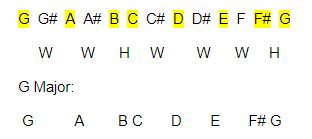
Ex. The Major pattern on F

We have two separate A notes and no B, as you can see. As a solution, it is preferable to use the flat-spelled form of the chromatic scale:
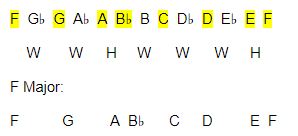
To understand what’s going on with the Major scales, consider the circle of 5ths. There is a way to arrange the 12 different chromatic pitches into a sequence of perfect fifths.
Scale Degrees: Simply, the note that you start on, for example, C, that note is your 1. The note after is 2, and so on until you come back to 1.
1 2 3 4 5 6 7 1
C D E F G A B C
The circle of fifths is essentially a clock face. The numbers one to seven are located on the right side and the numbers one to seven are on the left. You have C at the top as the zero since it has no sharps or flats. And every time you go around the clock-face to the right, you add a sharp (#).
So, for example, if you go to G, G is at point 1 on the clock face; thus, it has 1 sharp. And the sharp is always the seventh note of the scale. So the F is the 7th note of G Major, which you sharpen.
If you move around the clock face to the left, you’ll notice that flats (♭) occur this time. So, for example, you’ll begin at F, which has one flat. Instead of sharpening the 7th note, flatten the 4th note of the scale this time. The 4th note of the F Major is B; thus, you’ll make it B.
It’s well worth your effort to put this into practice. You’ll be able to take your grasp of how these scales are formed to a higher level by using the circle of 5ths.
Minor Scale
There are three different variants of the minor scale for each minor key. This includes the natural minor scale, the harmonic minor scale, and the melodic minor scale. All three of these minor scale variations share the same key signature.
In other words, you’re in the same minor key as before. But, you’ve got three versions of the scale to use while you’re creating, as well as when you’re performing music in a minor key.
1. Natural Minor Scale
Whenever the term “natural” shows up in music, it is code for indicating “normal” or “regular”. Not referring to sharp or flat, as the original pattern indicates.
Ex. The natural minor pattern on A

A minor (relative minor of C Major):
A B C D E F G A
W H W W H W W
A Major:
A B C# D E F# G# A
W W H W W W H
Seeing both the minor and the Major scale on the same note may help to internalize the logic.
The natural minor scale has a delightful tone. It’s modal and has an antique vibe about it. However, you may still want to hear a pull to the tonic, back to the first note. The harmonic minor scale comes in at this point:
2. Harmonic Minor Scale
The harmonic minor scale has the same key signature as the natural minor scale. Still, this time a semitone raises the 7th note, so if we go on with the A minor scale, the G becomes a G#.
Ex. The harmonic minor pattern on A
1 2 3 4 5 6 #7 1
A B C D E F G# A
Sharp and Flat Scale Degrees: G became G# in the preceding example, but there are flats in other scales. Scale degrees that are flat () don’t have sharps after them. The flat gets canceled out by the sharp. It is critical to consider sharps and flats as operators. The sharp raises the provided note by a semitone, whereas the flat lowers it by a semitone. Sharpening a B-flat will not make a B-sharp; it doesn’t work that way.
3. Melodic Minor Scale
The melodic minor scale differs from the harmonic minor scale in that it is different on the way up and down.
First, sharpen the sixth and seventh scale degrees on the way up:
1 2 3 4 5 #6 #7 1
A B C D E F# G# A
Following that, you’ll play the natural minor scale as it was initially designed on the way down.
1 2 3 4 5 6 7 1
A B C D E F G A
What are Modes in Music?
The modes have 7 notes per octave such as the major and minor scales. Even the order of the notes is the same, just with a different start time. For example, the Ionian mode is the major scale’s mode, and the Aeolian mode is the natural minor scale’s mode.
As a result, key signatures are the most straightforward approach to derive modes. So, for example, the key signature of G Major shows you all of the notes in G Major, and you have a half sharp in that key signature.
You’ll be playing modes if you start and end on a note other than G.
The modes’ names are mentioned below, along with the scale degrees at which they begin:
1 2 3 4 5 6 7 1
G A B C D E F# G
1. Ionian
2. Dorian
3. Phrygian
4. Lydian
5. Mixolydian
6. Aeolian
7. Locrian
1. Ionian
G Ionian is an example of how elements in music have several names. This pattern is simply a Major scale pattern. Except for the name, there is no difference.
2. Dorian
Dorian pattern starting on A:
W H W W W H W
A B C D E F# G A
3. Phrygian
Phrygian pattern starting on B:
H W W W H W W
B C D E F# G A B
4. Lydian
Lydian pattern starting on C:
W W W H W W H
C D E F# G A B C
5. Mixolydian
Mixolydian pattern starting on D:
W W H W W H W
D E F# G A B C D
6. Aeolian
Aeolian pattern starting on E:
W H W W H W W
E F# G A B C D E
7. Locrian
Locrian pattern starting on F#:
H W W H W W W
F# G A B C D E F#
Exotic scales
Byzantine/Double-Harmonic Scale: A Major scale with an m2nd and an m6th.
Diminished Scale: An octatonic minor scale.
Egyptian Scale: the 5th mode of the minor pentatonic scale.
Oriental Scale: A dominant scale with a minor 2nd and flattened 5th. Lower the 2nd, 5th, and 7th note to make a more oriental sound compared to the natural Major scale.
Hungarian Minor Scale: Double-harmonic minor scale, also the 4th mode of the double-harmonic/Byzantine scale.
Romanian Scale: Altered Dorian scale/Ukrainian Dorian scale, a minor scale with #4, also the 4th mode of the harmonic minor scale.
Phrygian Dominant Scale: The 5th mode of the harmonic minor scale.
Asavari Scale: Phyrigian scale without the minor 3rd and the minor 7th.
Japanese Scale: A five-note scale. Neither Major nor minor as the 3rd is not included.
Hirajoshi Scale: a popular Japanese pentatonic scale between the natural minor and minor pentatonic scales.
Unusual scales
A few examples of unusual scales are:
Hemitonic Pentatonic: 1, 2 b3, 5, 7 Ex. C, D, D#, G, B, C
Esoteric 6th: 2, 4, 6, 7 Ex. D, F, A, B, D
New Pentatonic: 1, 2, 3, b5, 6 Ex. C, D, E, F#, A, C
Summary
There are many things to say about musical scales. Learning about the mathematical side of music can be daunting. It is essential for beginners, however. Searching for simple but effective explanations may incredibly help. You may also start practicing with any scale you like or that you find more interesting. At a certain point, you’ll see that scales are all connected and that music is a scale in the end.


